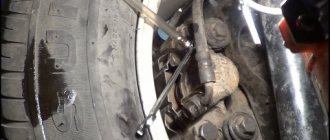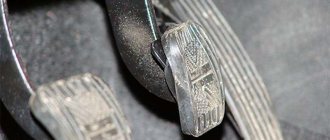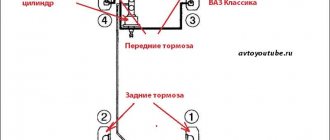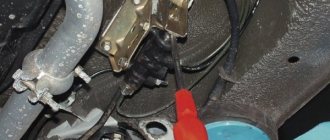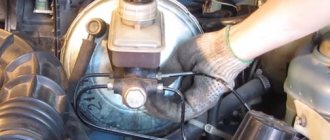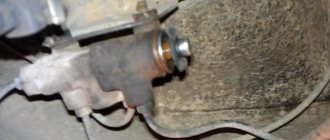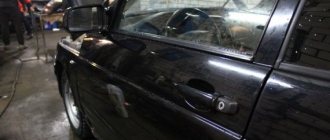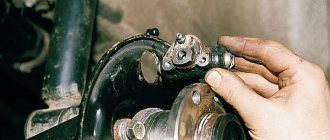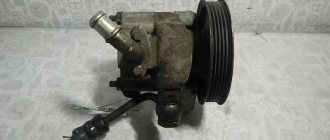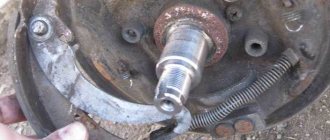Bleeding the vehicle's brake system must be carried out when repairing the brake system or replacing:
- brake fluid;
- brake pads;
- other elements of the braking system.
The main task is to remove air from the system, as well as clear and uniform operation of the brake mechanisms on each wheel. However, bleeding the brakes on cars without ABS is somewhat different from the same procedure on cars equipped with an anti-lock braking system. Read more in our article.
Types of ABS systems
The ABS system is a solution that prevents the wheels from completely locking during emergency braking. This allows you to maintain controllability and stability of the vehicle. It is important to understand that different types of such systems can be installed on different cars.
We can distinguish standard ABS systems, which by design consist of the following elements:
- hydraulic valve block;
- hydraulic accumulator;
- pump.
Such systems are simple; they can be pumped independently in a regular garage.
Also, the ABS system can have a device where the pump, hydraulic accumulator and hydraulic valve block are separately integrated into different units. Please note that this type of system can only be pumped with a diagnostic scanner!
The reason is that the brake system has ABS, ESP, SBC modules. A diagnostic scanner is required in order to be able to monitor the modulator valves.
Conclusion
After carrying out repair and maintenance work on critical components of the car, before driving, you must first check the tightness of the system and the operability of the vehicle components.
ABS - Anti-lock Braking System is a system against wheel locking during heavy braking. Thanks to the fact that ABS prevents the car from skidding along the road, safety increases in emergency situations. The anti-lock braking system will operate correctly if the system is not air-filled.
Watch this helpful video. Tests show that even a working ABS system turns off at the end of the braking distance, so you still need to modify it with your foot.
0
Author of the publication
offline 1 month
Bleeding standard ABS systems
In order to understand how to bleed ABS brakes with your own hands, it is first important to determine the type of system on a particular car. Below we will consider the pumping process using the example of a standard ABS system.
Provided that the system is standard, it is important to know the general rules of how to bleed the brakes. At the same time, bleeding ABS brakes is just as easy as bleeding a conventional brake system without ABS. We also note that on some car models, the brake bleeding scheme may differ slightly.
How to relieve pressure
Bleed the brake system starting from the front wheels, then pump the rear wheels. There is high pressure in the system (about 180 atmospheres), which must be relieved before pumping begins.
To do this, you need to discharge the pressure accumulator by removing the key from the ignition and pressing the brake about 15-30 times.
Next, you need to disconnect the connectors installed on the brake fluid reservoir. You also need to locate and remove the ABS fuse (located in the fuse box). Then the ABS pumping begins.
General pumping process
In short, on a car with ABS, the brakes are pumped as follows:
- First, the wheel is removed, the fitting of the working brake cylinder is discovered;
- the brakes are pumped when the pedal is depressed;
- turning on the ignition, the hydraulic pump is activated (ABS lamp is on);
- after activation, you need to wait until the air comes out;
- then the fitting is tightened, the brake pedal can be released;
The norm is when the ABS lamp no longer lights up. This indicates de-airing and the system is working properly.
The need to bleed ABS brakes
However, the anti-lock braking system is now extremely common, and almost all automakers include it in the list of standard equipment, even on budget models. Therefore, skill in bleeding this type of brake system is absolutely necessary.
Anti-lock braking system is an auxiliary system, the purpose of which is to prevent the car’s wheels from locking during braking. This is achieved by changing the pressure indicators in the brake mechanisms. Its operation prevents the car from skidding during heavy braking.
The main elements of this system are:
- ECU - control unit is guided by signals received from sensors, on the basis of which it adjusts the operation of the valves;
Electronic control unit
- Sensors – they are located directly on the vehicle’s hubs. Their task is to scan and provide the ECU with information regarding the car's acceleration, deceleration and current speed;
ABS system sensors
- Control valves - these elements are integrated both into the pressure modulator and into the lines of the main brake system.
Control valves in the ABS system
How to remove air from the brake system
When servicing your car yourself, it is important to know how to bleed the brakes. Start pumping from the front right wheel, then pump the front left. Typically, you need to start from the farthest wheel to the closest one in relation to the master cylinder.
Bleeding the front circuit is carried out with the ignition off, and the terminal on the brake system reservoir must be removed.
- A transparent hose is put on the fitting, the other end of the hose is completely lowered into a small container filled with liquid.
- Next, the fitting is opened with an open-end wrench. Air bubbles are clearly visible through the transparent hose when pumping.
- The brake pedal is depressed and held until the air is completely released. Then the fitting is tightened at the moment when liquid flows without air. Now the pedal can be released.
Bleeding the rear wheels
As for bleeding the contour of the rear wheels, they need to be pumped with the ignition on. Press the pedal and turn the key to activate the hydraulic pump. Then you need to control the process of air release.
You also need to monitor the brake fluid level in the reservoir. If necessary, fluid must be added. Please note that the pump cannot be operated without liquid! Do not allow the level of brake fluid in the reservoir to drop. The pump must not run continuously for more than 90 seconds!
To bleed ABS brakes on the rear left wheel, you should pay attention to the following nuances:
- putting the hose on the fitting, the fitting itself is not completely unscrewed (unscrewing it 1 turn is enough);
- The brake pedal should not be depressed;
- Having activated the hydraulic pump, after the air has escaped, the pedal is pressed halfway;
- then you can tighten the fitting, release the brake pedal and wait until the pump stops;
- Now the ignition is turned off, after which you can connect the tank connector;
We also recommend reading the article about which brake pads are best to choose. From this article you will learn about the features of selecting brake pads for a car, as well as what to look for when choosing brake pads for a car.
After bleeding the ABS brakes is completed, it is necessary to separately check the tightness of the brake system. Brake fluid leaks, brake pedal dips, very hard pedals, etc. are not allowed. You also need to additionally check the brake fluid level in the reservoir, adjusting it if necessary.
Additional elements of brake circuits
The disadvantage of old brakes was that one or more wheels would lock when the pedal was pressed to the floor. As a result, the car lost control and skidded, especially on slippery roads. Later, the traditional system was modernized by adding the following elements:
- hydraulic valve block;
- electric pump;
- capacity - hydraulic accumulator;
- wheel rotation sensors;
- electronic control module (ECU).
The listed components and parts are components of the anti-lock braking system. Thanks to them, a car with ABS never skids, since the automatic system simulates repeated sharp presses on the brake pedal, although the driver presses it all the way.
There are 2 types of brake circuits on cars: three- and four-channel. In the first case, the front wheels are connected to the main brake cylinder by separate branches, and the two rear wheels are connected by a single circuit. In the second scheme, each wheel has its own liquid line.
To understand the difference between bleeding a brake system with ABS, it’s worth understanding its operation:
- When the driver brakes under normal road conditions, the sensors on the wheels record approximately the same deceleration (taking into account turning) and the ABS does not manifest itself at all.
- When you press the pedal sharply, one or more wheels lock and rotate slower than the others, which the sensor reports to the ECU.
- At the command of the controller, the hydraulic unit opens the corresponding valve and the pressure in the circuit of the stopped wheel drops. Excess brake fluid flows into a storage tank.
- The pads release the disc (or drum) and the wheel spins along with the rest. But since the goal is to brake quickly, the ECU switches the valves again, the pads “grab” and hold the disc until the sensor detects the lock again. The cycle repeats until it stops completely.
- To prevent pressure in the master cylinder from dropping during valve actuation, an electric pump replenishes the brake fluid by pumping it from the hydraulic accumulator.
One described cycle takes a fraction of a second. The interaction of the fluid circuits with ABS is felt when the pedal is fully depressed. Due to the rapid operation of the valves and the pumping of fluid, the driver feels a series of shocks.
How to bleed the brakes alone
As a rule, it is much more convenient to bleed the brakes with two people. If this is possible, it is better to immediately invite an assistant, as the process is noticeably simplified. If there is no assistant, you can bleed the brakes yourself.
To do this, you use a gas stop (for example, a hood gas stop), as well as basic rules on how to bleed the brakes.
- After adding brake fluid to the master cylinder reservoir to the “maximum” level, press the brake pedal all the way several times.
- Next, the gas stop is placed between the seat and the brake pedal.
- Now you can bleed the brake fluid with air bubbles from the cylinders on the wheels according to the standard procedure.
We also recommend reading the article on how to check the ABS sensor on a car. In this article, you will learn about the symptoms of a malfunction, as well as the available methods for checking ABS sensors.
In this case, the gas stop constantly presses on the pedal, which makes it possible to do without an assistant. The main thing is that when pumping the brake cylinders on each wheel, you should constantly monitor the level of brake fluid in the reservoir. If the level drops, topping up is necessary.
When to change the brake fluid in a car
Brake fluid (FL), like any other, is characterized by a number of key operating parameters. One of them is its boiling point. It is about 2500 C. Over time, after prolonged use, this figure can decrease significantly. This phenomenon is due to the fact that the brake fluid is quite hygroscopic, and moisture, one way or another penetrating into the brake system, gradually reduces its performance characteristics.
In this regard, the threshold for its boiling sharply decreases, which can lead to serious consequences, including brake failure. The fact is that the operating temperature range of the fuel fluid is 170 - 1900 C, and if the percentage of moisture in it is high, under certain conditions it will simply begin to boil. This will inevitably lead to the appearance of air pockets, due to which the pressure in the system will be insufficient for effective braking.
Preparing for work
It is good to pump ABS brakes on an overpass or pit . Bleeding brakes with ABS, like bleeding a conventional brake system, is carried out with an assistant, starting the process of bleeding the brake system from the front wheels, then the rear (right and left). Shortly before starting work, it is recommended to inspect the threads of the brake bleeding fitting, for a smooth process: bleeding brakes
But first you need to determine what type of ABS system you have:
- If there is a simple ABS system, when all the components are in one housing, then it is enough to simply find the fuse, which in most cases is located in the system block. If you remove the fuse, the ABS system will be completely disabled. If you turn on the ignition, a light will come on, indicating that the ABS is faulty.
- Next, in the engine compartment, you need to find the cap on the expansion tank of the brake system and unscrew it. Before doing this, it is better to remove the connector from the electrical sensor.
- Then you need to look under the car, and near each wheel, find fittings for bleeding the working cylinders and loosen them. Here you need to make sure that the descenders do not break, because if they break, the work will take a long time. You can pre-treat the fittings with brake fluid or WD-40.
- In order to do the work accurately and at the highest level, you need to stock up on a flexible, clean hose whose internal diameter will be the same as the size of the fitting. And you need to pour about a third of the brake fluid into the bottle. By the way, you can buy brake fluid here: https://chaspik.org.ua/teh-jidkosti/tormoznyie-jidkosti/.
What types of ABS system is divided into?
There are two main options installed in cars:
- Simple - there is a single-channel one, which is installed on vans and rear-wheel drive cars, and a two-channel one - used separately for the front and rear axles. Brakes with a similar system can be bled in your own garage. The kit includes: a block with hydraulic valves, a pump, and a hydraulic accumulator.
- Complex - three-channel type, the wheels at the front are controlled independently, and at the rear, vice versa, simultaneously. There is also a four-channel version with an electronic unit that controls each of the 4 wheels separately. Used with ESP stability control system. A similar type is installed on Mercedes and Maybach models.
In four-channel mode, there is no direct connection between the entire system and the brake pedal itself. Cars with such ABS must only be pumped at a professional service station. To diagnose the problem, you will need a specialized scanner to monitor the functionality of the modulator valves.
What is the difference between bleeding brakes with ABS and without ABS?
Bleeding the brakes on a car with ABS is not an easy task, and the problem is not the complexity of the pumping process itself, but rather a lack of awareness. Bleeding brakes on a vehicle with ABS and without an anti-lock braking system differs significantly in some key points and has its own characteristics.
Three main differences between an anti-lock braking system and a conventional brake:
- In an ABS system, unlike non-ABS brakes, the piping system (the rear wheel circuit) is under increased pressure.
- The presence of an anti-lock braking system requires regular monitoring of the brake fluid level. If its level is at an extremely low level, the drive pump runs dry and begins to pump only air, thereby quickly stopping functioning.
- The operating time of the pump should not exceed two minutes, but if it has worked longer, it is necessary to turn on the ignition for ten minutes to cool it down.
